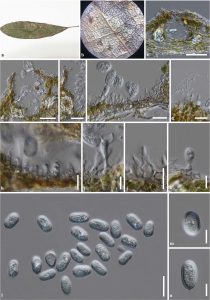Pseudoplagiostoma mangiferae Dayarathne, Phookamsak & K.D. Hyde, sp. nov., Index Fungorum number: IF555434
Etymology: The specific epithet ‘‘mangiferae’’ refers to the host genus Mangifera, of which the species was first collected.
Holotype: KUN-HKAS 102244
Associated with the leaf blight symptom on Mangifera sp. having amphigenous, subcircular to irregular, medium brown with blackish brown, reverse medium brown, surrounded by a purple-brown margin, which is dark brown in reverse. Sexual morph: Undetermined. Asexual morph: Coelomycetous. Conidiomata 70–140 μm high, 90–150 μm diam. (x̅ = 109 × 125 μm, n = 10), medium to dark brown, pycnidial with pale yellow drops of exuding conidia; subglobose, subcuticular to epidermal, with central rupture, breaking through plant tissue. Conidiomata walls 5–10 μm wide, thin-walled, composed of 2–4 layers of yellowish brown, pseudoparenchymatous cells, of textura angularis, intermixed with the host cells at the base and side. Paraphyses 0.8–2 μm wide, branched, septate, hyaline. Conidiophores absent. Conidiogenous cells 5–11 × 3.2–12.6 μm (x̅ = 9 × 6 μm , n = 30), proliferating enteroblastic, appearing as phialides with periclinal thickening and collarette, or with percurrent proliferation in the apical part; discrete, arising from the inner cell layer, hyaline, smooth, cylindrical to ampulliform, wider at the base, straight. Conidia 18–24 × 11–14 μm (x̅ = 22 × 13 μm, n = 50), hyaline, ellipsoidal, guttulate, smooth, thick-walled, aseptate, straight or slightly curved, frequently slightly narrow at the middle, with obtuse apex; base tapering to flat protruding scar.
Culture characteristics: Colonies on PDA reaching 80–85 mm diam. after 4 weeks at 20–25 ºC, sparse to medium sparse, circular, flat, surface slightly rough with tufts of hyphae, edge entire, woolly to cottony, radiating with sparse mycelia in the middle part; from above, pinkwhite to cream, from below, pale yellowish; not producing pigmentation in agar.
Material examined: CHINA, Yunnan Province, Xishuangbanna, Jinghong, Nabanhe, associated with leaf blight symtom on living leaf of Mangifera sp. (Anacardiaceae), 21 November 2015, R. Phookamsak, XB010 (KUN-HKAS 102244, holotype), ex-type living culture, KUMCC 18-0179.
GenBank numbers: ITS = MK084824, LSU = MK084825, TEF1-a = MK084822, TUB2 = MK084823.
Notes: Morphological characteristics clearly distinguish Pseudoplagiostoma mangiferae from other Pseudoplagiostoma species. The conidiogenous cells of P. mangiferae (5–11 × 3.2–12.6 μm) are wider than those of P. eucalypti (6–15 × 2–6 μm) (Cheewangkoon et al. 2010). Pseudoplagiostoma variabile is distinguished from P. mangiferae by its subglobose to bean-shaped, variable conidia shape (Cheewangkoon et al. 2010). The conidia of
P. corymbiae (14–19 × 7–10 μm), P. eucalypti (14–22 × 6–11 μ ), P. oldie (11–20 9 6–11 μm) and P. variabile (6.5–19 × 6.5–10.5 μm) are shorter than those of P. mangiferae (18.8–24 × 11.3–14.2 μm) while P. dipterocarpi (14–36 × 7–11 μm) has longer conidia (Cheewangkoon et al. 2010; Crous et al. 2012; Suwannarach et al. 2016). Furthermore, P. oldie is distinguished from P. dipterocarpi by its conidia turning brown when mature (Cheewangkoon et al. 2010). According to our multigene analyses, P. mangiferae shows a close phylogenetic relationship with P. dipterocarpi. However, they form well-separated lineages with high support (94% ML, 98% MP and 0.97 BYPP). A comparison of ITS nucleotide bases shows that P. mangiferae differs from P. dipterocarpi in 67/512 bp (13.1%). We therefore, introduce P. mangiferae as a new species following the guidelines of Jeewon and Hyde (2016).
Fig. Pseudoplagiostoma mangiferae (KUN-HKAS 102244, holotype). a Leaf blight symptom on living leaf of Mangifera sp. b Conidiomata on host surface. c, d Section through conidiomata. e, f Conidiomata walls at the side and the base respectively. g Paraphyses. h–k Conidiogenous cells. l–n Conidia. Scale bars c–e = 50 μm, f, g, l = 20 μm, h–k, m, n = 10 μm.

